Catahoula Issues is a large section of our site.
Please use the links below to navigate the pages within this section.
The Catahoula has a wide variety of solid colors as well as leopards (merles). Solid colors may be Black, Brown (Chocolate), Red, Yellow, White, and although not a true solid, Brindle is included
in the list.
The leopard dogs are actually solid colored dogs that have been affected by the merle gene. The merle gene is a diluting gene that affects the dark coat colors normally seen in dogs. The merle
gene will combine with the solid colors and create the merle pattern. This appears as patches of colored and white hairs intermingled with patches of solid colors. Black coats will appear with
patches of Blue or Gray, and Brown and Red coats will appear with lighter patches of Red or Liver. When this occurs, the dog will be referred to as a Leopard (Merle) colored dog. The merle gene does
not normally affect the entire coat of the dog, but dilutes the color only in areas that are randomly selected by the gene. White coats are visually unaffected.
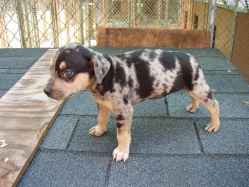
|
Gray leopards are those whose black coat has been diluted to display lighter colored areas that appear gray. Blue leopards are dogs whose coat is affected even more than the gray. Blue is just a
lighter color of gray brought about by the diluting effect. The greater majority of people looking for Catahoulas will state that they want a Blue Leopard, and will search everywhere to locate it.
Some breeders will state that they specialize in Blue Leopards, and will identify a Gray Leopard as being a little darker blue. Unsuspecting and unknowing customers will accept that explanation, and
purchase what they believe is a Blue Leopard. As stated above, the Blue Leopard Catahoula is nothing more than a lighter colored Gray.
|
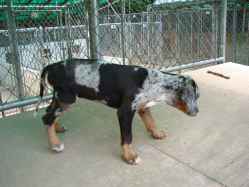
|
Black Leopards are those coats that have been least affected by the merle gene, and will display only small patches of blue or gray color. Theoretically it is still a merle colored dog that does
not display the large amounts of dilution seen in a Gray or Blue Leopard, and because it retained most of its natural black coat, it is referred to as a Black Leopard.
|
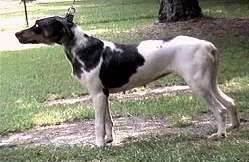
|
Patchworks are dogs whose coat is predominantly White with small amounts of solid and/or merle patches appearing throughout the coat. The colored patches may be Black, or Brown. Dilution may
affect those colored patches and produce gray, blue, red, or liver coloration within them.
|
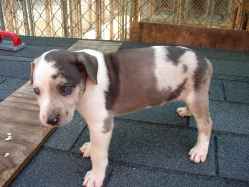
|
Tri-colored dogs are those with three distinct colors being visible. The majority of tri-colors are normally White, Black, and Gray. The colors may also appear as two varying shades of Gray or
Blue on a White background. Colors may also be Brown, Tan, Liver, or Red, but the background color will always be White with very distinct markings.
|
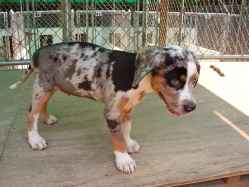
|
Quad-color, and the infamous Five colored, dogs are those that present the varying body colorations and trim colors that will help to designate the number of colors present on the dogs. For
example, a Gray Leopard may be considered a Quad-color when White and Tan trim are included. This dog would display Black, Gray, White, usually around the neck, face, feet and tail, and Tan, which
may also appear around the face and feet. Most Five colored dogs are actually misnamed Quad-colored dogs.
|
Leopard Dogs, as with almost any breed of dog, will darken with age. Keep that in mind when you are trying to make a decision on which color to choose.
Texture is another factor that affects coats. The Catahoula presents its coat texture almost in as many ways as it displays color. The texture can be slick, painted on coats, coarse, or shaggy,
wooly coats.

|
Slick, painted on coats are often referred to as Wash n' Wear coats. These coats are so slick that it appears as if the coat were painted on the dog and not hair at all. The hair is very short and
lies very close to the body. These coats dry very rapidly, and because of this, the dog can be cleaned and ready in a matter of minutes.
|
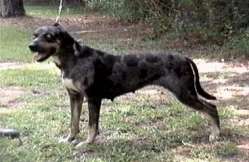
|
The Coarse coats are those whose hair is a little longer and fuller. These also require little maintenance, but are not quick to dry when wet. These coats will display the "feathers" often seen on
the rear legs, tail, and undercarriage.
|
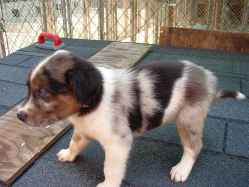
|
Although undesirable by most conformation standards, Shaggy, Wooly, or Double-Coated puppies will appear in some litters. The hair will not display itself until the puppies are about 3 weeks of
age. At that time, the coat will begin to appear wooly with the hair much longer and fuller, giving the appearance of a little wolf or bear. Most shaggy pups will shed their coats at about 12 weeks
and present a courser coat. Some of these will become double coated (also penalized in the standard) but still presentable as a representation of the breed. These coats will maintain a length similar
to that of a German Shepherd Dog. Others will maintain their shaggy appearance throughout their lives. Although not appealing to some, these dogs will still perform the same working functions as
their less hairy siblings.
|
Many people believe that the shaggy, wooly coats are being produced because of some interbreeding outside of the pedigree. This is not always the case. Although a mixing of breeds can produce that
effect, it will occur in litters of slick coated, pedigreed, Catahoulas. It is believed that the shaggy, wooly-coated dogs are produced through a combination of genes derived from the Red Wolf and
Beauceron. These canines have a course coat, and a fuller mane. It is widely believed that these genes, when combined, produce the undesirable coat texture. Because we cannot see inside the dog to
know which genes may present or contribute to this genetic feature, it is impossible to say when it will appear. Litters containing shaggy, wooly-coated dogs have been produced from parents that were
slick coated, and with no reported record of shaggy coats within the line.
Breeders maintaining the older bloodlines and lineages will see these shaggy pups occur most often. Reducing its occurrence is possible, but it can never be eliminated. The only means of reducing
the occurrence of these pups is to eliminate breeding the pair that produced the litter. Shaggy puppies will generally be placed in pet homes, or with hunters or ranchers. They do not care about
appearance, but only stability in their pet, or the dog's ability to work.
As is the case in life, most owners will choose the dog that aesthetically appeals them. Looks is the most important factor in their choice. Unfortunately, choosing a dog on its appearance alone
sometimes results in the owner coming to despise the dog because its inherited habits, such as chewing, digging, temperament, and energy levels.
If you have made the decision to acquire a Catahoula, please take into consideration all of the facets of this breed, and realize that coat color and texture are only visually pleasing factors in
the make-up of this truly versatile dog.
|
